Traffic Engineering
The city’s Traffic Engineering division plans and manages city projects to improve traffic flow and safety. These projects include conducting traffic studies, managing traffic control devices and signs, and approving traffic control plans in the city’s right-of-way.
If you have questions about traffic engineering or would like to submit your home or business area for a traffic study, please submit a work request to Traffic Engineering via Scottsdale EZ.
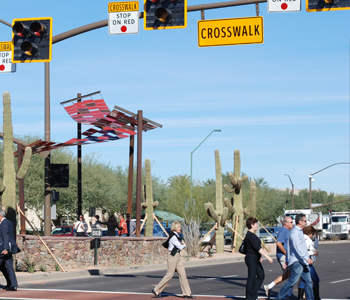 Pedestrian Crossings
Pedestrian Crossings
The Pedestrian Element of Scottsdale’s Transportation Action Plan (TAP) prioritizes enhanced pedestrian crossings including bridges, tunnels, pedestrian refuge islands, pedestrian hybrid beacons and rectangular rapid flashing beacons. The city’s Guidelines to Identify Pedestrian Crossing Treatments (PDF) is a document that outlines the city’s decision-making process for identifying and prioritizing areas for enhanced pedestrian crossings.
Pedestrian Hybrid Beacon
The city has eleven pedestrian hybrid beacons (PHB). The PHB’s are sometimes referred to as a High Intensity Activated Crosswalk (HAWK). PHB’s are installed on busy streets, and in high pedestrian areas, to help make crossing safer. Unlike traditional traffic signals pedestrian hybrid beacons operate only when a pedestrian pushes the crossing button. Vehicles are free to move through the intersection when no one is crossing the street and should respond to yellow and red lights as they would with any other traffic signal. View the Pedestrian Hybrid Beacons map (PDF).
How a Pedestrian Hybrid Beacon signal works:
- The beacon is normally in an “off” position and operates only when a pedestrian pushes the crossing button.
- Once activated, a yellow flashing light will alert drivers approaching the crosswalk to slow down.
- The flashing yellow light is followed by a solid yellow light, alerting drivers to prepare to stop.
- The solid yellow light is followed by a solid red light, alerting drivers to stop.
- Pedestrians will see a walk signal and hear an audible crossing countdown.
- The solid red light will be flowed by a flashing red light alerting drivers that they may proceed through the intersection when it safe to do so.
Rectangular Rapid Flashing Beacon
A Rectangular Rapid Flashing Beacon (RRFB) is a traffic control device used to increase driver awareness at crosswalks. The device is typically used in marked mid-block crossings and at uncontrolled intersections. When activated the RRFB emits amber colored lights that flash in irregular patters to alert drivers of their responsibility to yield to pedestrians in the crosswalk. Pedestrians can activate the RRFB by pushing a crossing button, in some applications the device is activated by pedestrian movement.
High Visibility Crosswalks and Pedestrian Refuge Islands
The city uses a variety of pedestrian crossing treatments to meet the unique needs of Scottsdale’s non-motorized street users. These crossing treatments include high visibility striped crosswalks, pedestrian refuge islands and separated grade crossings. Please see the city’s Guidelines to Identify Pedestrian Crossing Treatments for complete information.
Neighborhood Traffic Management Program
If you have concerns about speeding on your neighborhood street, Scottsdale’s Neighborhood Traffic Management Program (NTMP) (PDF) offers strategies that can help reduce speeding. The city’s Transportation & Streets Department works with citizens and the Scottsdale Police Department to improve speed awareness within neighborhoods, encourage safe driving speeds and provide helpful engineering solutions. If you think your neighborhood might be a candidate for the NTMP program, please submit a request through Scottsdale EZ or call the Transportation and Streets Department at 480-312-7250 for further assistance. Please see the city’s Neighborhood Traffic Management Policy for complete information about the program.
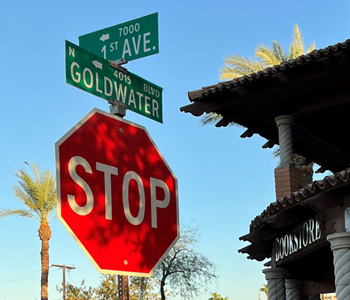 Traffic Signs
Traffic Signs
Traffic signs provide critical instructions to motorists, pedestrians, and cyclists. Signs are placed along, or above roads and highways, to guide, warn and regulate the safe flow of traffic. Scottsdale, like all cities in the nation, adheres to the Manual on Uniform Traffic Control Devices (MUTCD). Use of these standards provide uniformity in transportation and driver recognition and understanding of signage.
Multiway Stop Intersections
A stop sign is used at an intersection to assist drivers and pedestrians in determining who has the right-of-way. Multiway stop signs are used at intersections when traffic volumes on all approaches are approximately equal and at intersections where safety is a concern. The decision to install a multiway stop is based on an engineering study with considerations that include traffic volumes and collision history. Multiway stops are not to be used for speed control or to arbitrarily interrupt traffic.
Streetlight Improvement Project
The city’s Streetlight Improvement project is replacing damaged and end-of-life streetlights with LED fixtures. LED technology provides consistent illumination and a more concentrated light distribution pattern allowing technicians to direct the light onto roadways, sidewalks, and crosswalks in the public right-of-way. The fixtures have a high color rendering index (CRI), which means the fixture displays colors more accurately, enhancing community safety and improving visibility for drivers. LED fixtures are International Dark Sky (IDS) compliant and reduce the amount of light expended into the sky and onto private property. The fixtures have built-in photometric options and do not require external directional shields.
LED streetlights are energy-efficient and consume less electricity, resulting in significant energy savings for the city and its residents. The fixtures can last up to10 times longer than conventional streetlights which helps reduce maintenance costs. Cities throughout the Valley, and local power companies, are converting streetlights to LED technology. Scottsdale has more than 14,000 streetlights; the city maintains 9,000 of these fixtures and has converted approximately 3,000 to LED technology. Residents can expect to see more fixtures converted to LED technology in the coming years.
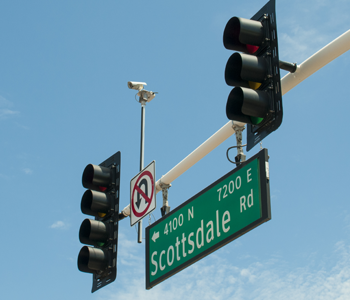 TRAFFIC SIGNALS
TRAFFIC SIGNALS
Traffic signals are valuable devices for the control of vehicle and pedestrian traffic. Because they assign the right-of-way to the various traffic movements, signals have a profound influence on traffic flow. When property located and operated, signals may reduce the frequency of collisions, provide for the orderly movement of traffic, and increase the traffic-handling capacity of an intersection.
Traffic Signal Requirements
The Federal Highway Administration developed nine traffic signal warrants contained in the Manual on Uniform Traffic Control Devices (MUTCD). These warrants, or requirements, define the minimum conditions under which a signal may be justified; the manual states that traffic signals should not be installed unless one or more of the signal warrants are satisfied. However, the satisfaction of a warrant or warrants is not justification for a signal. Each situation is unique and must be analyzed on a case-by-case basis.
Flashing Yellow Left Turn Traffic Signals
Flashing yellow arrow traffic signals feature a flashing yellow arrow in addition to the standard red, yellow and green arrows. When illuminated the flashing yellow arrow allows motorists to make a left-hand turn after yielding to oncoming vehicles and pedestrians. Other than that, the signal works the same as a traditional signal.
Flashing Yellow Turn Signals operate as follows:
- Steady red arrow = Stop (no left turns allowed)
- Steady yellow arrow = Prepare to stop
- Flashing yellow arrow = Left turns allowed, vehicles must yield to oncoming traffic
- Steady green arrow = Left turns allowed
The use of flashing yellow left-turn arrows is the result of extensive research sponsored by the National Cooperative Highway Research Program. The research showed the flashing left-turn arrow was the most easily understood indication for drivers and is widely accepted in the traffic engineering industry.
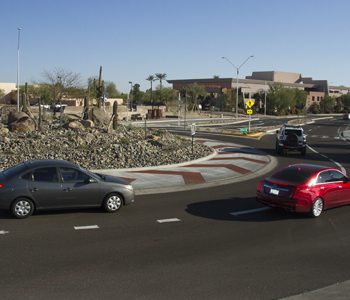 ROUNDABOUTS
ROUNDABOUTS
Scottsdale is a roundabout first city, which means that roundabouts are evaluated for effectiveness and feasibility in all projects that include intersections. According to the Federal Highway Administration, roundabouts are proven safety additions to transportation infrastructure, reducing severe crashes at intersections by up to 80 percent. In addition to lowering collision rates, and severity of collisions, roundabouts reduce delays and lower emissions. View a map of roundabouts in Scottsdale. (PDF)
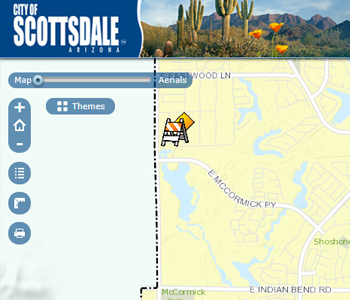 TRAFFIC Restrictions
TRAFFIC Restrictions
The city reviews more than 12,000 on-street barricade plans, or traffic control plans, each year. Requests are submitted to the city by contractors who need to work in the city’s roadways. Road work includes paving projects, infrastructure maintenance, utility upgrades and commercial and residential developments.
The city’s Traffic Engineering team approves plans for every road construction project in the city’s right-of-way. Plans are reviewed to ensure vehicle and pedestrian safety, police and fire access during construction and phasing with other projects. It is also important that road projects do not interfere with Scottsdale’s event season or restrict access to event venues.
View the Traffic Restrictions map.
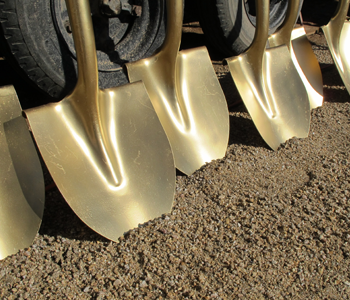 PRIVATE DEVELOPMENT TRAFFIC IMPACT STUDIES
PRIVATE DEVELOPMENT TRAFFIC IMPACT STUDIES
The city’s Traffic Engineering team works alongside city planners to analyze the impacts of proposed development on existing transportation systems. If additional infrastructure is needed, developers are required to provide the city with a Traffic Impact Mitigation Analysis (TIMA) document that details the expected impact to the local transportation network. City traffic engineers may request developers to adjust site plans to mitigate traffic impacts or request improvements such as roundabouts, traffic signals, pedestrian crossings, or additional turning lanes based on their review of the TIMA report. The city will also utilize the report to review the attributes of proposed developments in conjunction with requests for annexation, land subdivision, zoning changes, building permits, or other development review. The city completed 43 TIMA reviews in 2022. The Scottsdale Design Standards & Policy Manual (DSPM) outlines the TIMA requirements.
A TIMA document addresses the following issues:
- The current transportation system and operation characteristics in the site vicinity
- The interface between the on-site circulation system and the adjacent circulation system
- The intensity and character of development
- Trip generation
- Capacity and Safety impacts of the proposed developments on existing and planned transportation systems
Contact Information
City of Scottsdale - Transportation
7447 E. Indian School Rd., Suite 205
Scottsdale, AZ 85251
P: 480-312-7250
TDD: 480-312-5419
F: 480-312-4000
Traffic Engineering
P: 480-312-7250
Street Operations
P: 480-312-5620
Traffic Management Center
P: 480-312-7777 (6 a.m. - 6 p.m. weekdays)
[email protected]

